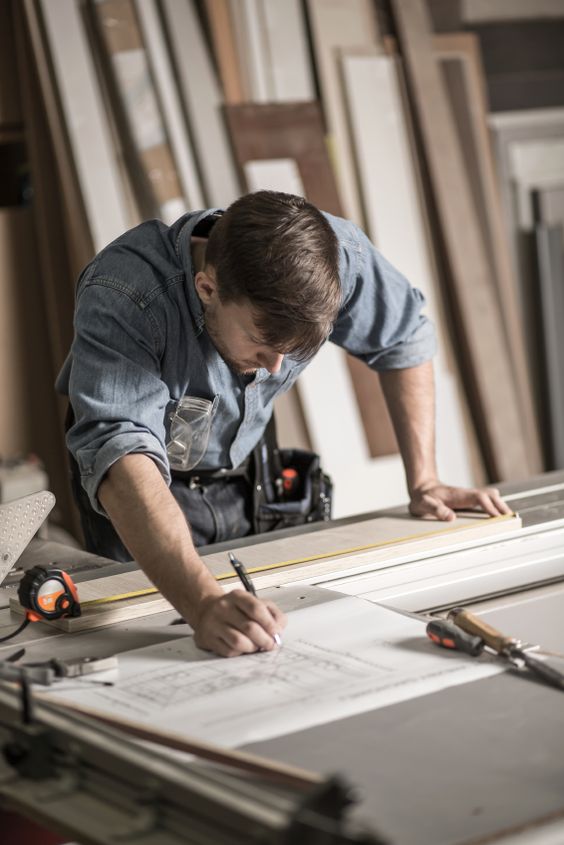[vc_row type= »in_container » full_screen_row_position= »middle » column_margin= »default » scene_position= »center » text_color= »dark » text_align= »left » overlay_strength= »0.3″ shape_divider_position= »bottom » bg_image_animation= »none »][vc_column column_padding= »no-extra-padding » column_padding_position= »all » background_color_opacity= »1″ background_hover_color_opacity= »1″ column_link_target= »_self » column_shadow= »none » column_border_radius= »none » width= »1/1″ tablet_width_inherit= »default » tablet_text_alignment= »default » phone_text_alignment= »default » overlay_strength= »0.3″ column_border_width= »none » column_border_style= »solid » bg_image_animation= »none »][vc_column_text]
Étape 1 : Vérifier s’il y a une proportionnalité dans la diagonale de vos murs pièce.
Désormais vous savez que vos murs ne sont pas droits. Si c’est le cas, il y a deux cas de figure.
Tout d’abord le premier cas de figure : vous n’avez ni les mêmes équidistances ni les mêmes mesures. Dans ce cas, vous pouvez passer directement à la deuxième étape et opter pour l’option « dossier » ou « désassemblé ».[/vc_column_text][/vc_column][/vc_row][vc_row type= »in_container » full_screen_row_position= »middle » column_margin= »default » scene_position= »center » text_color= »dark » text_align= »left » overlay_strength= »0.3″ shape_divider_position= »bottom » bg_image_animation= »none »][vc_column column_padding= »no-extra-padding » column_padding_position= »all » background_color_opacity= »1″ background_hover_color_opacity= »1″ column_link_target= »_self » column_shadow= »none » column_border_radius= »none » width= »1/1″ tablet_width_inherit= »default » tablet_text_alignment= »default » phone_text_alignment= »default » overlay_strength= »0.3″ column_border_width= »none » column_border_style= »solid » bg_image_animation= »none »][vc_column_text]1.Problème d’équidistance
Vous faites partie de ce cas de figure : si vous avez mesuré 2 équidistances différentes lors de vos prises de dimensions mais que vous avez les mêmes 3 mesures (flèche noirs).[/vc_column_text][/vc_column][/vc_row][vc_row type= »in_container » full_screen_row_position= »middle » column_margin= »default » scene_position= »center » text_color= »dark » text_align= »left » overlay_strength= »0.3″ shape_divider_position= »bottom » bg_image_animation= »none »][vc_column column_padding= »no-extra-padding » column_padding_position= »all » background_color_opacity= »1″ background_hover_color_opacity= »1″ column_link_target= »_self » column_shadow= »none » column_border_radius= »none » width= »1/1″ tablet_width_inherit= »default » tablet_text_alignment= »default » phone_text_alignment= »default » overlay_strength= »0.3″ column_border_width= »none » column_border_style= »solid » bg_image_animation= »none »][image_with_animation image_url= »1488″ alignment= »center » animation= »Fade In » hover_animation= »none » border_radius= »none » box_shadow= »none » image_loading= »default » max_width= »100% » max_width_mobile= »default »][/vc_column][/vc_row][vc_row type= »in_container » full_screen_row_position= »middle » column_margin= »default » scene_position= »center » text_color= »dark » text_align= »left » overlay_strength= »0.3″ shape_divider_position= »bottom » bg_image_animation= »none »][vc_column column_padding= »no-extra-padding » column_padding_position= »all » background_color_opacity= »1″ background_hover_color_opacity= »1″ column_link_target= »_self » column_shadow= »none » column_border_radius= »none » width= »1/1″ tablet_width_inherit= »default » tablet_text_alignment= »default » phone_text_alignment= »default » overlay_strength= »0.3″ column_border_width= »none » column_border_style= »solid » bg_image_animation= »none »][vc_column_text]Dans ce cas prenez maintenant les mesures des flèches bleues comme dans le schéma ci-dessous. Il faut maintenant vérifier si vos mesures augmentent de manière proportionnelle.[/vc_column_text][/vc_column][/vc_row][vc_row type= »in_container » full_screen_row_position= »middle » column_margin= »default » scene_position= »center » text_color= »dark » text_align= »left » overlay_strength= »0.3″ shape_divider_position= »bottom » bg_image_animation= »none »][vc_column column_padding= »no-extra-padding » column_padding_position= »all » background_color_opacity= »1″ background_hover_color_opacity= »1″ column_link_target= »_self » column_shadow= »none » column_border_radius= »none » width= »1/1″ tablet_width_inherit= »default » tablet_text_alignment= »default » phone_text_alignment= »default » overlay_strength= »0.3″ column_border_width= »none » column_border_style= »solid » bg_image_animation= »none »][image_with_animation image_url= »1487″ alignment= »center » animation= »Fade In » hover_animation= »none » border_radius= »none » box_shadow= »none » image_loading= »default » max_width= »100% » max_width_mobile= »default »][/vc_column][/vc_row][vc_row type= »in_container » full_screen_row_position= »middle » column_margin= »default » scene_position= »center » text_color= »dark » text_align= »left » overlay_strength= »0.3″ shape_divider_position= »bottom » bg_image_animation= »none »][vc_column column_padding= »no-extra-padding » column_padding_position= »all » background_color_opacity= »1″ background_hover_color_opacity= »1″ column_link_target= »_self » column_shadow= »none » column_border_radius= »none » width= »1/1″ tablet_width_inherit= »default » tablet_text_alignment= »default » phone_text_alignment= »default » overlay_strength= »0.3″ column_border_width= »none » column_border_style= »solid » bg_image_animation= »none »][vc_column_text]Sur cet exemple, la longueur augmente de 10 cm à chaque mesure, la longueur augmente donc de manière proportionnelle.
Si votre longueur augmente de manière proportionnelle entre vos 3 distances, il est alors possible de créer des canapés marocains sur mesure à votre pièce.[/vc_column_text][/vc_column][/vc_row][vc_row type= »in_container » full_screen_row_position= »middle » column_margin= »default » scene_position= »center » text_color= »dark » text_align= »left » overlay_strength= »0.3″ shape_divider_position= »bottom » bg_image_animation= »none »][vc_column column_padding= »no-extra-padding » column_padding_position= »all » background_color_opacity= »1″ background_hover_color_opacity= »1″ column_link_target= »_self » column_shadow= »none » column_border_radius= »none » width= »1/1″ tablet_width_inherit= »default » tablet_text_alignment= »default » phone_text_alignment= »default » overlay_strength= »0.3″ column_border_width= »none » column_border_style= »solid » bg_image_animation= »none »][vc_column_text]2. Problème de mesures
Si les 3 mesures que vous avez prises sont différentes, vous avez également un problème d’angle droit.
Dans ce cas, il vous suffit de reprendre ces mesures et d’observer si celles-ci augmentent de manière proportionnelle.[/vc_column_text][/vc_column][/vc_row][vc_row type= »in_container » full_screen_row_position= »middle » column_margin= »default » scene_position= »center » text_color= »dark » text_align= »left » overlay_strength= »0.3″ shape_divider_position= »bottom » bg_image_animation= »none »][vc_column column_padding= »no-extra-padding » column_padding_position= »all » background_color_opacity= »1″ background_hover_color_opacity= »1″ column_link_target= »_self » column_shadow= »none » column_border_radius= »none » width= »1/1″ tablet_width_inherit= »default » tablet_text_alignment= »default » phone_text_alignment= »default » overlay_strength= »0.3″ column_border_width= »none » column_border_style= »solid » bg_image_animation= »none »][image_with_animation image_url= »1486″ alignment= » » animation= »Fade In » hover_animation= »none » border_radius= »none » box_shadow= »none » image_loading= »default » max_width= »100% » max_width_mobile= »default »][/vc_column][/vc_row][vc_row type= »in_container » full_screen_row_position= »middle » column_margin= »default » scene_position= »center » text_color= »dark » text_align= »left » overlay_strength= »0.3″ shape_divider_position= »bottom » bg_image_animation= »none »][vc_column column_padding= »no-extra-padding » column_padding_position= »all » background_color_opacity= »1″ background_hover_color_opacity= »1″ column_link_target= »_self » column_shadow= »none » column_border_radius= »none » width= »1/1″ tablet_width_inherit= »default » tablet_text_alignment= »default » phone_text_alignment= »default » overlay_strength= »0.3″ column_border_width= »none » column_border_style= »solid » bg_image_animation= »none »][vc_column_text]Sur cet exemple, la largeur augmente de 5 cm à chaque mesure, la largeur augmente donc de manière proportionnelle.
Si vos mesures augmentent de manière proportionnelle entre vos 3 prises de dimensions qui sont effectué à équidistances les unes des autres, il est alors possible de créer des canapés marocains sur mesure à votre pièce.[/vc_column_text][/vc_column][/vc_row][vc_row type= »in_container » full_screen_row_position= »middle » column_margin= »default » scene_position= »center » text_color= »dark » text_align= »left » overlay_strength= »0.3″ shape_divider_position= »bottom » bg_image_animation= »none »][vc_column column_padding= »no-extra-padding » column_padding_position= »all » background_color_opacity= »1″ background_hover_color_opacity= »1″ column_link_target= »_self » column_shadow= »none » column_border_radius= »none » width= »1/1″ tablet_width_inherit= »default » tablet_text_alignment= »default » phone_text_alignment= »default » overlay_strength= »0.3″ column_border_width= »none » column_border_style= »solid » bg_image_animation= »none »][vc_column_text]
Étape 2. Trouver la solution appropriée
Si vous avez rencontré un problème de mesure ou d’équidistance (comme dans les 2 cas précédents). Vous avez le choix entre 3 options :
- Créer un canapé sur mesure tenant compte de vos dimensions.
Avec un croquis des dimensions de votre pièce et des dimensions des canapés que vous souhaitez, nous serons en mesure de vous créer un canapé sur mesure à votre pièce.
- Ajouter des dossiers à votre canapé pour ne pas avoir besoin de l’accolé au mur.
- Créer un canapé « désassemblé » avec des pièces de canapé entre sur différents murs sans former d’angles droit
[/vc_column_text][/vc_column][/vc_row][vc_row type= »in_container » full_screen_row_position= »middle » column_margin= »default » scene_position= »center » text_color= »dark » text_align= »left » overlay_strength= »0.3″ shape_divider_position= »bottom » bg_image_animation= »none »][vc_column column_padding= »no-extra-padding » column_padding_position= »all » background_color_opacity= »1″ background_hover_color_opacity= »1″ column_link_target= »_self » column_shadow= »none » column_border_radius= »none » width= »1/1″ tablet_width_inherit= »default » tablet_text_alignment= »default » phone_text_alignment= »default » overlay_strength= »0.3″ column_border_width= »none » column_border_style= »solid » bg_image_animation= »none »][image_with_animation image_url= »1485″ alignment= »center » animation= »Fade In » hover_animation= »none » border_radius= »none » box_shadow= »none » image_loading= »default » max_width= »100% » max_width_mobile= »default »][/vc_column][/vc_row][vc_row type= »in_container » full_screen_row_position= »middle » column_margin= »default » scene_position= »center » text_color= »dark » text_align= »left » overlay_strength= »0.3″ shape_divider_position= »bottom » bg_image_animation= »none »][vc_column column_padding= »no-extra-padding » column_padding_position= »all » background_color_opacity= »1″ background_hover_color_opacity= »1″ column_link_target= »_self » column_shadow= »none » column_border_radius= »none » width= »1/1″ tablet_width_inherit= »default » tablet_text_alignment= »default » phone_text_alignment= »default » overlay_strength= »0.3″ column_border_width= »none » column_border_style= »solid » bg_image_animation= »none »][vc_column_text]Attention de prendre en compte les éventuels obstacles (poteaux, radiateur, etc…)
Si vous n’avez ni les mêmes équidistances, ni les mêmes mesures :
Vous devrez choisir entre l’option « dossier » ou « canapé désassemblé » mais il sera impossible de créer un canapé sur mesure à vos dimensions.[/vc_column_text][/vc_column][/vc_row][vc_row type= »in_container » full_screen_row_position= »middle » column_margin= »default » scene_position= »center » text_color= »dark » text_align= »left » overlay_strength= »0.3″ shape_divider_position= »bottom » bg_image_animation= »none »][vc_column column_padding= »no-extra-padding » column_padding_position= »all » background_color_opacity= »1″ background_hover_color_opacity= »1″ column_link_target= »_self » column_shadow= »none » column_border_radius= »none » width= »1/1″ tablet_width_inherit= »default » tablet_text_alignment= »default » phone_text_alignment= »default » overlay_strength= »0.3″ column_border_width= »none » column_border_style= »solid » bg_image_animation= »none »][vc_column_text]
Étape 3 : Faites votre croquis avec vos dimensions
Vous pouvez imprimer et utiliser le modèle ci-dessous pour réaliser votre croquis. Nous l’avons fait pour illustrer les 3 exemples précédents. Il vous suffit simplement de partir des pointillés et de dessiner le croquis de votre canapé.
N’oubliez pas de préciser le plus de dimensions possibles. Si vous souhaitez obtenir un devis ou simplement un conseil, vous pouvez directement nous envoyer votre croquis par mail : contact@moncanapemarocain.com[/vc_column_text][image_with_animation image_url= »1484″ alignment= »center » animation= »Fade In » hover_animation= »none » border_radius= »none » box_shadow= »none » image_loading= »default » max_width= »100% » max_width_mobile= »default »][vc_column_text]
Étape 4 : Déterminer l’épaisseur de votre mousse
25 cm de mousse équivaudra à 48 cm de hauteur avec support
30 cm de mousse équivaudra à 53 cm de hauteur avec support
Il s’agit de notre référence de hauteur, celle-ci peut varier selon la boutique dans laquelle vous souhaitez acheter votre salon marocain.
Une fois que vous avez déterminer toutes vos dimensions, vous pouvez passer aux dernières étapes de création du salon : le choix du design, du confort et du support.
N’hésitez pas à imprimer cet article pour vous aider lors de vos prises de dimensions. Il est nécessaire de bien mesurer vos pièces et de prendre en compte tous les éventuels obstacles de votre pièce pour ne pas avoir de mauvaise surprise le jour de l’emménagement de votre salon.[/vc_column_text][vc_column_text]Cas spécial :
Si votre pièce possède des dimensions très spécifiques mais simple comme dans le cas ci-dessous, il est également possible de demander un devis mais nous aurons besoin d’un maximum d’informations sur les dimensions de votre pièce.[/vc_column_text][image_with_animation image_url= »1483″ alignment= »center » animation= »Fade In » hover_animation= »none » border_radius= »none » box_shadow= »none » image_loading= »default » max_width= »100% » max_width_mobile= »default »][vc_column_text]Proportionnalité diagonale :[/vc_column_text][image_with_animation image_url= »1482″ alignment= »center » animation= »Fade In » hover_animation= »none » border_radius= »none » box_shadow= »none » image_loading= »default » max_width= »100% » max_width_mobile= »default »][vc_column_text]
Source : Pinterest[/vc_column_text][/vc_column][/vc_row][vc_row type= »in_container » full_screen_row_position= »middle » column_margin= »default » scene_position= »center » text_color= »dark » text_align= »left » overlay_strength= »0.3″ shape_divider_position= »bottom » bg_image_animation= »none »][vc_column column_padding= »no-extra-padding » column_padding_position= »all » background_color_opacity= »1″ background_hover_color_opacity= »1″ column_link_target= »_self » column_shadow= »none » column_border_radius= »none » width= »1/1″ tablet_width_inherit= »default » tablet_text_alignment= »default » phone_text_alignment= »default » overlay_strength= »0.3″ column_border_width= »none » column_border_style= »solid » bg_image_animation= »none »][social_buttons facebook= »true » pinterest= »true »][/vc_column][/vc_row]


